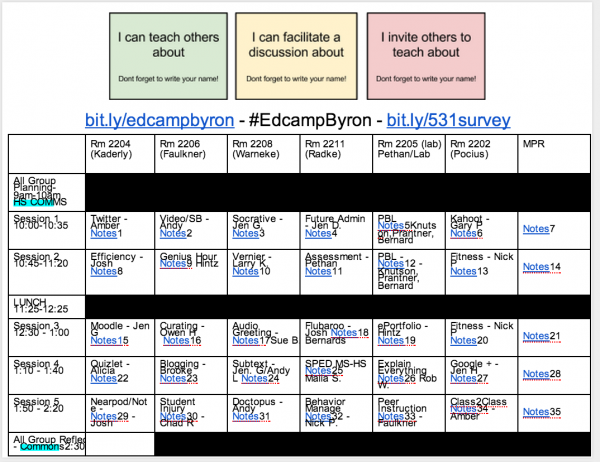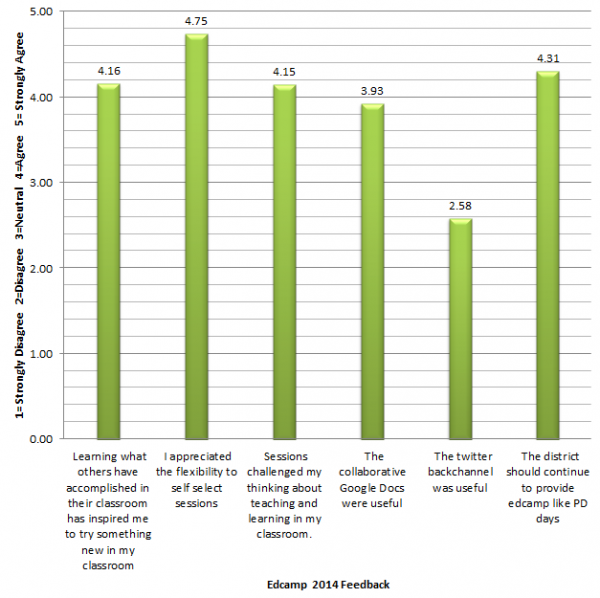Yesterday was a great day. Probably one of the funnest inservice (oxymoron?) days I have participated in a while. What made it fun? We decided to run the day edcamp style. That is right. No hired experts. No hours of sit and get with no time to collaborate with peers. No pre-selected sessions with polished presentations. Instead, with approximately 60-70 teachers we were able to crowdsource a schedule with 30 PD sessions in 30 minutes… For our teachers, by our teachers.
So how did we pull this off? I am going to highlight some tips as well as some ideas we have already to improve our next go around.
- Attend an Edcamp. A small group of Byron staff(@mr_weyers, @rockychat3, mrbernards and I) took off on a Saturday in October to attend #EdcampMSP in Osseo MN. While our main agenda was to observe an edamp in action… we also got caught up in the learning and sharing too. Made some great connections and made some new friends (adding to my PLN!). What I noticed about the day was the energy and the growth mindset of every individual at the conference. I also found it was great to observe Edcamp gurus @lisasjogren and @tombrandtt in action and I appreciate their support (tweets, hangouts, emails) as we expanded this idea into our district.
- Send a video short video to staff to let them know what to expect on the edcamp day. This was a great suggestion by Andy (@rockychat3) and I would highly recommend you do the same. There is just something about a short video clip that can clear up any well articulated email/plan. 2 minutes or less would be good. Here is a link to ours. http://goo.gl/IVfO3k. (yes, its not high quality – but it did the job)
- The Introduction. I think this was a critical component of the day.
- Intro “Teachers this is about you today. You decide what you want to learn, you have input to what gets on the schedule” I forewarned…this could be messy. I don’t know what to expect. I have no idea if this will work, but its worth a try. (in my head….This is a risk and it may fail and I am putting myself out there in front of our teachers ). We also introduced the 3 post-its at this time. So people would start jotting down ideas.
- It was also important to highlight active participation. If you feel you are not in the right room, move. Its ok. . Other ways to participate – Listen, participate in the discussion, help take notes.
- Presenters. Your job – please show up at the time allotted to you. Essentially it takes 2 or more people to get a session to go. If some sessions only have 2 people in the room that is ok because the right people are in the room. (idea from Osseo script)
- Build the schedule. A couple of us with microphones would walk around the room to see if people would first sign up. Later it was to engage others. Many had post-its filled out, but wouldn’t call them out. I could walk by and ask, what do you need and hopefully spark a session.
- As the date neared, the whole idea of the on the fly scheduling part scared me. I had no idea if it would work. What if we don’t get people to share? What if we don’t get people to make requests? What if awkward silence is what our planning session ends up being? I must have visited the scheduling process at least a thousand times in my mind. Should it be totally analog and then transfer it to a doc/site? How long should sessions be? How long in between sessions? How many sections of sessions?
- Our decision – we will build it live on Gdocs, and project it for the staff as well as provide a short URL (so staff could follow on their devices). The doc had a table with five 1/2 hour sessions and 7 rooms. Collaborative notes were pre-loaded on every section. During the event, we had 2 people man the schedule and watch for conflicts. (like presenters who offered multiple sessions to not be scheduled at the same time)
- Its important as you build the schedule you move down the doc and to the right. A last minute decision. The last room (mpr) would be an overflow room. If the dialog was so good, that a half hour was not enough, we suggested people go into the overflow room. We also wanted everyone to come together and reflect on the day (and take survey). (Improvements for next year – maybe have some coaches available in the afternoon so people could actually start working through their ideas. Feedback we received also suggested that descriptions be provided on the docs. So – maybe as we are building the schedule, once it gets placed – the facilitators could actually give a short description of what to expect when walking into a session. Also – maybe recap the day with a smack down? Might be nice to offer a section of hour long sessions. It might provide some depth and support)
- So what happened? It took the first 1 or 2 people to make their requests and the ball got rolling. I think this may have been one of the more intriguing parts of the day. Having input into what is being presented. 5 out of the 30 sessions were not necessarily technology related, but were very aligned to our district vision as well as other district initiatives so they also were perfect for the day too. Remember, this was our Teachers Day to decide. Some sessions were demonstrations, others were conversations.
- A key point – administrators should make a strong effort to attend. I absolutely loved it that our HS principal was actively learning with the rest of the teachers. This is very VERY powerful. If you are an administrator, and your district/building is hosting an edcamp. Try and make an effort to participate… actively. This is a great way to gain insight to the innovation happening in our classrooms as well as build relationships with a wide group of teachers. This one day could go a long way. (Idea – invite board members?)
- Results. It was pretty cool today when I walked into the school and I overheard teachers still talking about the event. We tried to remember what we did the year before – nobody could remember. So, I hope this will be memorable. We received some great feedback and data from our survey. This will be instrumental in the NEXT TIME. One note – The twitter backchannel was probably the least successful of the event. However, I do not view it as a failure but as a benchmark to improve. As more teachers get connected, it would be great for them to see value in tools like twitter.
So, was the unconference powerful? YES. The energy was amazing, empowering. Everyone was an expert and many people who have never led a PD session, were leading. Having a day to connect with other staff outside of a classroom or discipline or building was also very effective. At the end, I shared George Couros quote from Ties 13 conference “The smartest person in the room, is the room”. Try and unconference/edcamp and you too will see the power of collaborative learning.





